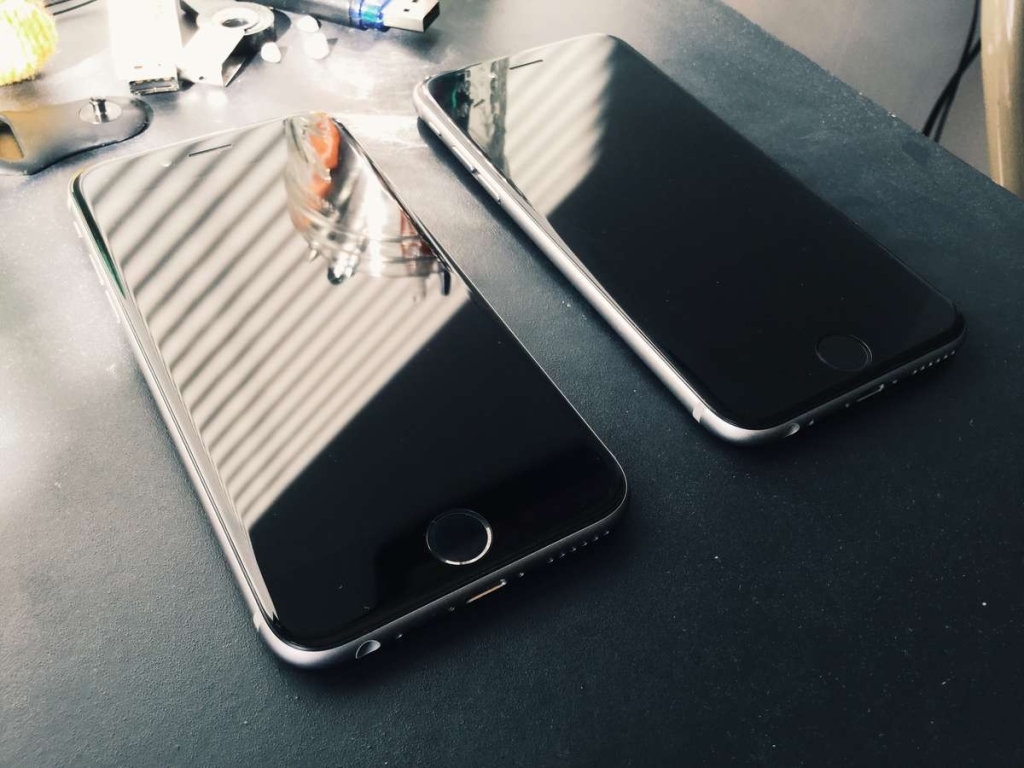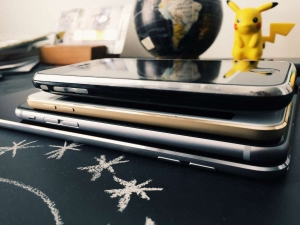The new Apple iPhone 6S, released in September 2015, follows the company’s distinct “Tick-Tock” pattern when it comes to smartphones: refresh the phone’s look one year (“Tick”) while improving internal specs and features the next (“Tock”). Both parts of the iPhone cycle often bring new features. But while one iPhone gets its foot in the door with the help of an updated look, its younger but supercharged successor is frequently met with one recurring question: “how’s it different?”
It’s true that iPhone 6S looks very familiar, but it’s not an exaggeration to say the changes introduced along with it could affect the smartphone experience forever. Here’s how it’s different.
Design
Many saw the iPhone 6, released just over a year ago in September 2014, as a callback to the original iPhone’s physical design. For the first time since 2007, the flagship iOS device had an all-aluminum back with rounded edges. That device’s antenna lines were reminiscent of HTC’s M8 and the phone was Apple’s first voyage into larger phone territory—sticking with 4 inches and below claiming single-handed usability trumped all.
Well, good news for those that liked that design: Apple’s giving it an encore. But also making sure to address a few of its most glaring shortcomings.
iPhone 6S, iPhone 6 & iPod Touch
The iPhone 6S looks exactly like the iPhone 6. Minus those ugly markings at the bottom
Last year, some iPhone 6 Plus users noticed their device was bending through standard use around the area where the volume buttons were located. Popular gadget journalist Lewis of Unbox Therapy put a spotlight on the “Bendgate” issue—pointing out that thinner aluminum has a harder time retaining its shape. In response, Apple has opted for 7000 Series aluminum alloy this time (which the company happily points out is used in the aerospace industry).
iPhone 6S owners will probably notice the same-looking phone now feels heavier, and it is: the iPhone 6S weighs 5.04 ounces while the iPhone 6 weighs 4.55 ounces, though that difference is due to other factors as well as the case. But I personally preferred this change.
Though it’s not entirely about looks. “Design is how it works” as the late Apple founder Steve Jobs once famously said. What functionality has been added?
3D Touch
The Apple Watch’s For
ce Touch made way for 3D Touch on the iPhone 6S
When the iPhone debuted in 2007, Apple touted the device’s inclusion of multi-touch—allowing touchscreen users to pinch the screen with two fingers and zoom-in. Cupertino didn’t invent multi-touch, but it made it a default feature for nearly every smartphone after it. The original iPhone didn’t have copy/paste, 3G or even video recording. But if you planned on making a phone anytime after 2007, multi-touch was now mandatory. This year on the iPhone 6S, Apple’s inclusion of a new touchscreen interactivity feature called 3D Touch is on this same level of significance.
The traditional desktop has matured to allow multiple avenues to arrive at the same destination. Menu bar options, menus activated by right-clicking your mouse cursor, and keyboard shortcuts all allow you to copy, paste, highlight, preview and overall bend the computing experience to what’s most comfortable for you. 3D Touch (which—if you’re like me, you’ll continue to call Force Touch for a while, as it is the name of the feature as originally introduced on the Apple Watch) brings a similar paradigm shift when it comes to adding more functionality to the touchscreen beyond the familiar actions of tap, tap and hold (“long press”), and pinch.
Pushing quickly but firmly into a homescreen icon causes a stylish translucent menu to appear over that icon, letting you select between various options. These let you jump directly into the section of the app you want from the homescreen itself. But this is just the tip of the iceberg, and relatively boring compared to what 3D Touch allows for inside of apps.
Now, for example, when someone texts you a link in the Apple Messages app, pushing into it previews the webpage in a separate window. Pushing with even more force fully opens up the website in the Safari app. Apple calls these actions “Peek” and “Pop,” and they work in a few third-party apps too, like Instagram and Dropbox. But I’m expecting more third-party developers to take advantage of the new functionality in the coming weeks and months, and that will truly make 3D Touch not just cool to use, but nearly indispensable.
Live Photos capture motion from before and after you snap a photo
Apple’s also bringing GIF-style animated photo creation to iOS with Live Photos. On by default, camera users can use 3D Touch to push into their photo and reveal a few seconds before and after the shot was taken. As we see above with BB-8.
The new multitasking gesture I previously criticized makes much more sense when used with 3D Touch. Similar to the right-swipe to move back gesture, swiping right and pushing inward reveals the most recently used apps. Doing it quickly brings you straight to your last app.
Based on the new affordances of this feature, I can almost see a future where Apple doesn’t include a home button at all, relying solely on 3D Touch for navigation in and out of apps.
But I can’t talk about 3D Touch without mentioning text selection. Push into the keyboard to move the cursor, let up and push in again to select text.
Touch ID
Apple introduced their fingerprint reader alongside the iPhone 5S back in 2013. Instead of requiring a four or more digit passcode to enter the device, TouchID allowed Apple to integrate a fingerprint scanner into the home button—allowing you to wake your device and enter it with just one tap. Many of the competition like Samsung’s latest devices have caught up and added fingerprint sensors to their phones as well. The iPhone 6S one-ups the competition by making it nearly instantaneous.
The new fingerprint sensor is good. Almost too good, actually. Your first week or two, new iPhone 6S owners are bound to accidentally enter the phone multiple times when they simply wanted to view their latest notifications. Thankfully, Apple also clearly thought about this when designing the software for the new iPhone as well: the new Notifications Center in iOS 9 presents your notifications in chronological order, ensuring that you don’t miss the latest information when waking the phone and quickly entering with Touch ID.
3D Touch is a novel feature. Though the faster TouchID sensor is the most important aspect of the iPhone 6S right now. The iPhone 5S and 6 required users to deliberately leave their finger to let it be scanned when entering the device. The 6s, however, feels like it employs an invisible barrier to keep out strangers—there when you need it, seemingly invisible when you don’t.
Hey Siri
Setting up Siri is now similar to TouchID
Thankfully, no. The iOS 9 software update also asks you to “train,” Siri to recognize only your voice. Similar to TouchID, users say a few phrases so Siri can get accustomed to the sound of your voice, and identify it from everyone else’s. Apple’s assistant may still not be as feature-filled as Google Now’s voice features, being able to summon Siri using only your voice feels right. While I now never use the home button to access Siri, I actually use her more than before.
Also, the new Siri waveform animations and splashes of color in the background look cooler than ever.
Camera
After four entire years of the iPhone’s 8-megapixel shooter, Apple’s flagship device has finally received an increase. The rear iSight shooter now weighs in at 12 megapixels while the front-facing FaceTime camera measures up to 5 megapixels now—up from 1.2.
For the past few years, Apple has claimed that many phone manufacturers put too much emphasis on increasing the pixel count and not addressing other areas that matter—pixel size, for example. Here’s the iPhone 6S camera in action:
iOS 9
There are many new features that come standard with iOS now in the latest iteration, iOS 9. So much so that it’s almost deserving of its own, separate post. But there a few new features here that greatly affect using the new iPhone 6S.
Abilities like the app switcher 3D Touch gesture and Live Photos are 6S-specific iOS 9 features. And options like “Back To” your previous app in the top left of the screen, or Siri searching your email for phone number caller ID, are useful (even if the latter only works with Apple’s Mail client).
But the most striking aspect in terms of using the phone day-to-day comes in the form of iOS 9’s ad blockers. In short: Browsing the web on the iPhone is now inherently faster than on Google’s Android devices.
iOS now offers the best web browsing experience
To the chagrin of some web publishers and advertising companies, Apple has built-in the ability for apps to plug into the Safari web browser and other web views on the iPhone, and block the advertisements that ordinarily would show up on webpages. Apps like Crystal, Purify and (formerly) Peace prevent the browsing experience from being muddied by distracting advertisements. Meaning your favorite sites will probably see less revenue, since you’re not seeing or clicking on those ads, but also browsing the web on iOS is now a much smoother experience, since the ads no longer have to download onto your device.
We saw Apple play this card in the war against Adobe Flash. When the iPhone was first released Apple argued—similar to ads today—that Flash added unnecessary cruft to websites and, therefore, had to go. Flash was tightly integrated into most websites, but it was in the name of a better browsing experience. The difference between Flash and ads is it’s also in Apple’s best interest monetarily: ads are a huge revenue source for, you guessed it, Google. The search company last year made 75% of its revenue—$9 billion—from Apple’s iOS. Very bad news for Alphabet.
Anyway, back to the phone review.
Battery
The iPhone 6S battery is largely similar to the iPhone 6 battery. Unlike “S” releases, the 6S battery is smaller than the option before it: the 6S 1715 mAh is down from the iPhone 6’s 1810 mAh. Though while smaller than before, the iPhone still gets about the same lifespan—presumably due to software optimization on Apple’s part.
We should note, our iPhone 6S review unit is of the TMSC variety. Whew.
The iPhone was never one to win the spec race. It’s important to note you’ll probably find beefier batteries on the Android side. You’ll have to plug in at least once a day with the iPhone 6S still.


